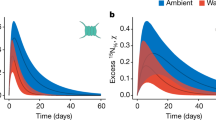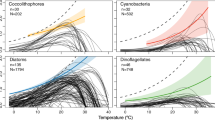Abstract
Synergies between large-scale environmental changes, such as climate change1 and increased humic content (brownification)2, will have a considerable impact on future aquatic ecosystems. On the basis of modelling, monitoring and experimental data, we demonstrate that community responses to global change are determined by food-chain length and that the top trophic level, and every second level below, will benefit from climate change, whereas the levels in between will suffer. Hence, phytoplankton, and thereby algal blooms, will benefit from climate change in three-, but not in two-trophic-level systems. Moreover, we show that both phytoplankton (resource) and zooplankton (consumer) advance their spring peak abundances similarly in response to a 3 °C temperature increase; that is, there is no support for a consumer/resource mismatch in a future climate scenario. However, in contrast to other taxa, cyanobacteria—known as toxin-producing nuisance phytoplankton3—benefit from a higher temperature and humic content irrespective of the food-chain composition. Our results are mirrored in natural ecosystems. By mechanistically merging present food-chain theory with large-scale environmental and climate changes, we provide a powerful framework for predicting and understanding future aquatic ecosystems and their provision of ecosystem services and water resources.
This is a preview of subscription content, access via your institution
Access options
Subscribe to this journal
Receive 12 print issues and online access
$209.00 per year
only $17.42 per issue
Buy this article
- Purchase on Springer Link
- Instant access to full article PDF
Prices may be subject to local taxes which are calculated during checkout



Similar content being viewed by others
Change history
18 September 2012
In the version of this Letter originally published online, the authors Alice Nicolle (A.N.) and P. Anders Nilsson (P.A.N.) were incorrectly credited in the Author contributions section; the correct author contributions should have been “L-A.H., C.B. and A.N. designed the study; A.N., L-A.H., P.H., A.P., C.B., J.B., E.K. and W.G. performed the study; L-A.H., A.N., P.A.N. and P.H. analysed the data…” These errors have now been corrected in all versions of the Letter.
References
Christensen, J. H. et al. in IPCC Climate Change 2007: The Physical Science Basis (eds Solomon, S. et al.) (Cambridge Univ. Press, 2007).
Monteith, D. T. et al. Dissolved organic carbon trends resulting from changes in atmospheric deposition chemistry. Nature 450, 537–539 (2007).
Brookes, J. D. & Carey, C. C. Resilience to blooms. Science 333, 46–47 (2011).
Moss, B. et al. How important is climate? Effects of warming, nutrient addition and fish on phytoplankton in shallow lake microcosms. J. Appl. Ecol. 40, 782–792 (2003).
Petchey, O. L., McPhearson, P. T., Casey, T. M. & Morin, P. J. Environmental warming alters food-web structure and ecosystem function. Nature 402, 69–72 (1999).
Jansson, M., Persson, L., De Roos, A. M., Jones, R. I. & Tranvik, L. J. Terrestrial carbon and intraspecific size-variation shape lake ecosystems. Trends Ecol. Evol. 22, 316–322 (2007).
Graham, M. D. & Vinebrooke, R. D. Extreme weather events alter planktonic communities in boreal lakes. Limnol. Oceanogr. 54, 2481–2492 (2009).
Cushing, D. H. Plankton production and year-class strength in fish populations—an update of the match mismatch hypothesis. Adv. Mar. Biol. 26, 249–293 (1990).
Kosten, S. et al. Warmer climates boost cyanobacterial dominance in shallow lakes. Glob. Change Biol. 18, 118–126 (2012).
Lappalainen, J., Tarkan, A. S. & Harrod, C. A meta-analysis of latitudinal variations in life-history traits of roach, Rutilus rutilus, over its geographical range: Linear or non-linear relationships? Freshwat. Biol. 53, 1491–1501 (2008).
Hansson, L-A. et al. Consequences of fish predation, migration and juvenile ontogeny on zooplankton spring dynamics. Limnol. Oceanogr. 52, 696–706 (2007).
Sarnelle, O., Gustafsson, S. & Hansson, L-A. Effects of cyanobacteria on fitness components of the herbivore Daphnia. J. Plankton Res. 32, 471–477 (2010).
Jeppesen, E. et al. Climate change effects on runoff, catchment phosphorus loading and lake ecological state, and potential adaptations. J. Environ. Qual. 38, 1930–1941 (2009).
Winder, M. & Schindler, D. E. Climate change uncouples trophic interactions in an aquatic ecosystem. Ecology 85, 2100–2106 (2004).
Adrian, R., Wilhelm, S. & Gerten, D. Life-history traits of lake plankton species may govern their phenological response to climate warming. Glob. Change Biol. 12, 652–661 (2006).
Nicolle, A. et al. Predicted warming and browning affect timing and magnitude of plankton phenological events in lakes: A mesocosm study. Freshwat. Biol. 57, 684–695 (2012).
Gillooly, J. F., Charnov, E. L., West, G. B., Savage, V. M. & Brown, J. H. Effects of size and temperature on developmental time. Nature 417, 70–73 (2002).
Hairston, N. G., Smith, F. E. & Slobodkin, L. B. Community structure, population control, and competition. Am. Nat. 94, 421–425 (1960).
Carpenter, S. R., Kitchell, J. F. & Hodgson, J. R. Cascading trophic interactions and lake productivity: Fish predation and herbivory can regulate lake ecosystem. Bioscience 35, 634–639 (1985).
Daufresne, M., Lengfellner, K. & Sommer, U. Global warming benefits the small in aquatic ecosystems. Proc. Natl Acad. Sci. USA 106, 12788–12793 (2009).
Reich, P. B. et al. Plant diversity enhances ecosystem responses to elevated CO2 and nitrogen deposition. Nature 410, 809–812 (2001).
Suttle, K. B., Thomsen, M. A. & Power, M. E. Species interaction reverse grassland responses to changing climate. Science 315, 640–642 (2007).
Estes, J. A. et al. Trophic downgrading of planet earth. Science 333, 301–306 (2011).
Carpenter, S. Microcosm experiments have limited relevance for community and ecosystem ecology. Ecology 77, 677–680 (1996).
Spivak, A. C., Vanni, M. J. & Mette, E. M. Moving on up: Can results from simple aquatic mesocosm experiments be applied across broad spatial scales? Freshwat. Biol 56, 279–291 (2011).
Gerten, D. & Adrian, R. Climate-driven changes in spring plankton dynamics and the sensitivity of shallow polymictic lakes to the North Atlantic Oscillation. Limnol. Oceanogr. 45, 1058–1066 (2000).
Straile, D. Meteorological forcing of plankton dynamics in a large and deep continental European lake. Oecologia 122, 44–50 (2000).
Gyllström, M. et al. Interactions between climate, predation and productivity in shaping the zooplankton communities of shallow lakes. Limnol. Oceanogr. 50, 2008–2021 (2005).
Paine, R. T. Food Webs—linkage, interaction strength and community infrastructure—the 3rd Tansley Lecture. J. Anim. Ecol. 49, 667–685 (1980).
Cohen, J. Statistical Power Analysis for the Behavioural Sciences 2nd edn (Lawrence Erlbaum, 1988).
Acknowledgements
The study was financed by the Swedish Research Council for the Environment and Spatial Planning (Formas), and the Swedish Research Council (VR) through the Centre for Animal Movement Research (CAnMove) supported by a Linnaeus grant (349-2007-8690). This is a contribution from the strategic research area Biodiversity and Ecosystems in a Changing Climate. J. and A. Bäckman provided the temperature system. L. Hansson assisted in designing the figures and B. Chapman kindly checked the language.
Author information
Authors and Affiliations
Contributions
L-A.H., C.B. and A.N. designed the study; A.N., L-A.H., P.H., A.P., C.B., J.B., E.K. and W.G. performed the study; L-A.H., A.N., P.A.N. and P.H. analysed the data; L-A.H. wrote the paper. All authors commented on the manuscript.
Corresponding author
Ethics declarations
Competing interests
The authors declare no competing financial interests.
Supplementary information
Supplementary Information
Supplementary Information (PDF 220 kb)
Rights and permissions
About this article
Cite this article
Hansson, LA., Nicolle, A., Granéli, W. et al. Food-chain length alters community responses to global change in aquatic systems. Nature Clim Change 3, 228–233 (2013). https://doi.org/10.1038/nclimate1689
Received:
Accepted:
Published:
Issue Date:
DOI: https://doi.org/10.1038/nclimate1689
This article is cited by
-
Hatching under brownification: DOC-mediated changes in physical, but not chemical properties of water affect hatching patterns of Cladocera resting eggs
Environmental Science and Pollution Research (2022)
-
Elevated temperature and browning increase dietary methylmercury, but decrease essential fatty acids at the base of lake food webs
Scientific Reports (2021)
-
Phytoplankton communities in temporary ponds under different climate scenarios
Scientific Reports (2021)
-
Phytoplankton and anthropogenic changes in pelagic environments
Hydrobiologia (2021)
-
Phytoplankton responses to meteorological and hydrological forcing at decadal to seasonal time scales
Hydrobiologia (2021)



